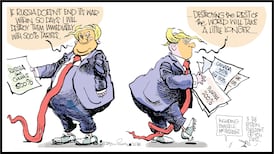Last weekend, like the weekend before, Gerry Adams was out on the circuit, honouring the IRA dead. While the people of the Short Strand were rallying against the killers of Robert McCartney, Gerry Adams was in Creggan in south Armagh, presiding over a commemoration for Brendan Burns and Brendan Moley, who blew themselves up with their own bomb in February 1988.
The events might seem discordant, and it was certainly no fun for the Sinn Féin president to have to devote his speech to a desperate attempt to distance his movement from the butchery. But they were in fact two facades of the same edifice.
When Adams says that no republican worthy of the name could be involved in criminal acts, he was relying on a contrast between noble, courageous heroes like Brendan Burns and the bad people who killed Robert McCartney. There are cowardly thugs who gang up on a defenceless man and stern warriors who confronted the might of the British army.
As it happens, Brendan Burns was one of the most effective IRA operatives of the entire conflict. But it's not at all clear that he ever put himself in personal danger, except from his own bombs.
His 10-year career, indeed, is emblematic of the gap between the IRA's heroic self-image and its great skill in inflicting more suffering than it endured. What Brendan Burns was very good at was placing bombs on roadsides and getting the hell out of there before they exploded.
He is widely believed to have planted the IRA bombs that killed 18 British soldiers at Warrenpoint in 1979 and five soldiers at Camlough two years later. Most of those who died in these explosions were in their late teens or early twenties.
They were, by the IRA's logic, legitimate targets, though, of course, IRA men killed by the British army were victims of a vile shoot-to-kill policy. It is perhaps naive to expect that a commemoration like Sunday's would have heard some reminder that the photographs of the aftermath of the Warrenpoint explosion were so horrific that the coroner at the inquest instructed that they not be shown to female members of the jury.
Such complexities have to be filtered out of the collective memory of Sinn Féin and the IRA, all the more so when the movement's involvement in thuggery and criminality is being exposed as never before.
Ask an apologist for the IRA about its continued existence nearly seven years after its demand for an act of self-determination by the Irish people was met, and you will get two answers. The first is that the IRA is essentially defensive, that it did and does protect the Catholic people from aggression. This is a straightforward lie.
The IRA has killed around 90 Catholics in west Belfast, and its various offshoots around another 40. The UDA killed 10, the UFF 22, the UVF 37, the British army 82, the RUC 14. And after the initial phase of the conflict, when the IRA arguably helped to fight off large-scale assaults on Catholic areas, there is not a shred of evidence that the IRA ever protected Catholic civilians.
The other line of defence is the H-Block hunger strikes of 1980 and 1981, whose importance for the self-justification of the movement was evident when Mitchel McLaughlin, in his now infamous remarks that the killers of Jean McConville were not criminals, immediately asked "Was Bobby Sands a criminal?". But this line, too, is beginning to crumble with the publication of Richard O'Rawe's book Blanketmen. O'Rawe was one of the IRA leaders in the H-Blocks at the time of the hunger strikes.
His account contrasts sharply with the official version constructed by Gerry Adams. In his autobiography, Gerry Adams says of the hunger strikes that "My role now was to chair Sinn Féin's hunger strike committee". O'Rawe makes it clear that Adams represented, not Sinn Féin, but the IRA army council.
Adams says of the hunger strikers that "there was very good liaison with them, but in the final analysis, although we gave the families what help was within our power, it was up to the prisoner to work out the consequences of the hunger strike with his family; it wasn't up to us."
The whole tenor of his account is that the hunger strike was run entirely by the prisoners. O'Rawe says that Adams, on behalf of the army council, effectively prevented the prisoners from accepting a deal offered by the British after four hunger strikers had died.
He writes that the army council, at best, miscalculated in a way that cost another six lives, and, at worst, kept the strike going long enough to ensure Owen Carron's election in Fermanagh/South Tyrone. Either way, "there can be no doubt that the army council called the shots".
Thus, even the most heroic and self-sacrificing moment of the IRA campaign begins to look like a murky, calculating and perhaps cynical strategy to gain the moral high ground.
It is not surprising that O'Rawe, when he raised his concerns with a senior IRA figure in 1991, was warned that he "could be shot" if he spoke out in public. Back then, intimidation worked. Now the McCartney family have given the IRA a lesson in real bravery: the courage to defy threats and speak the truth.










